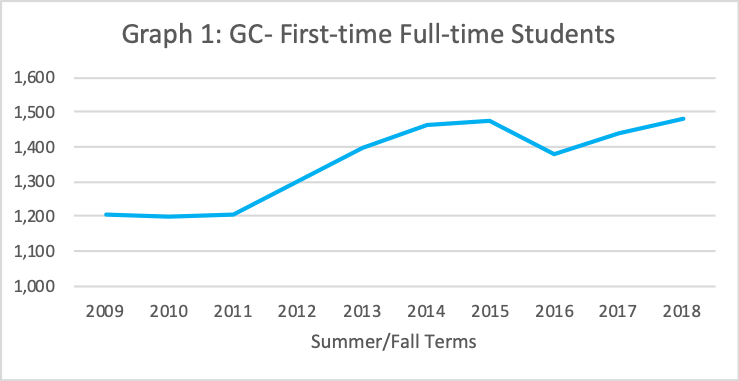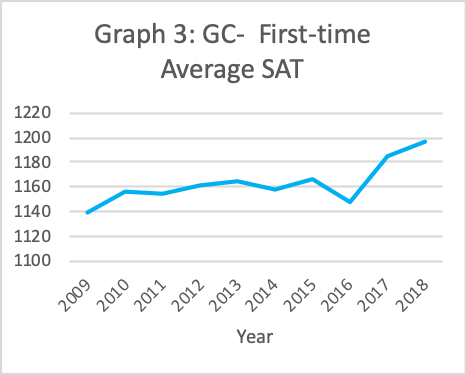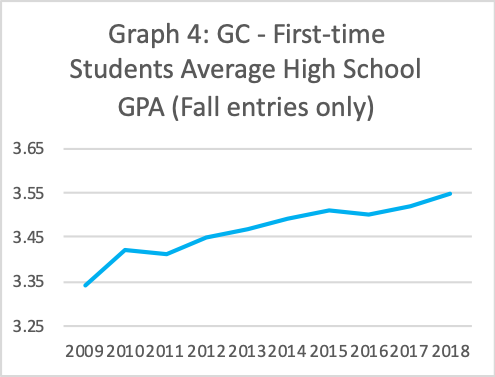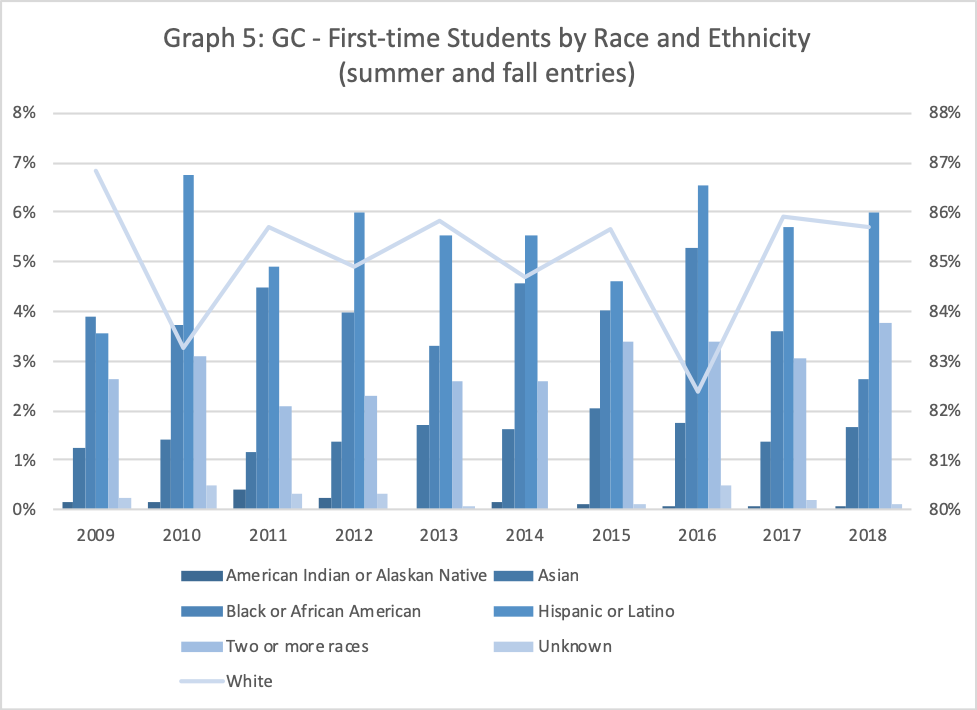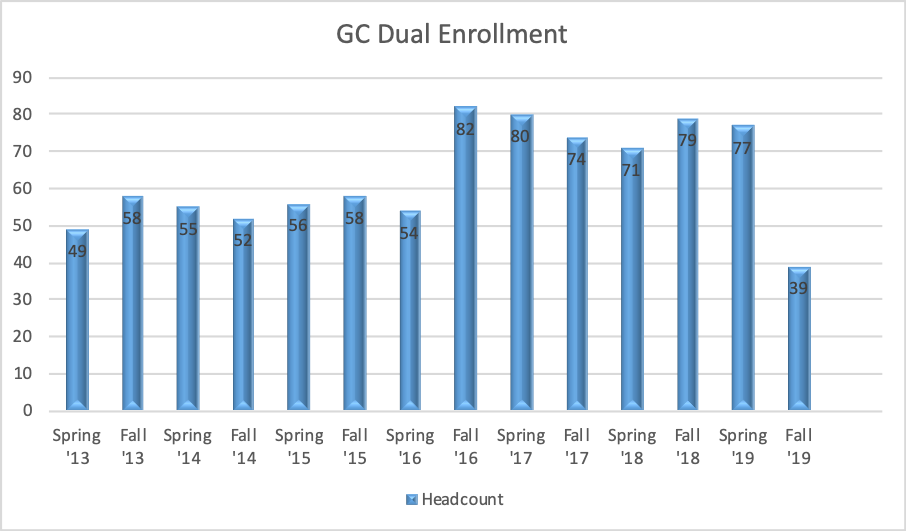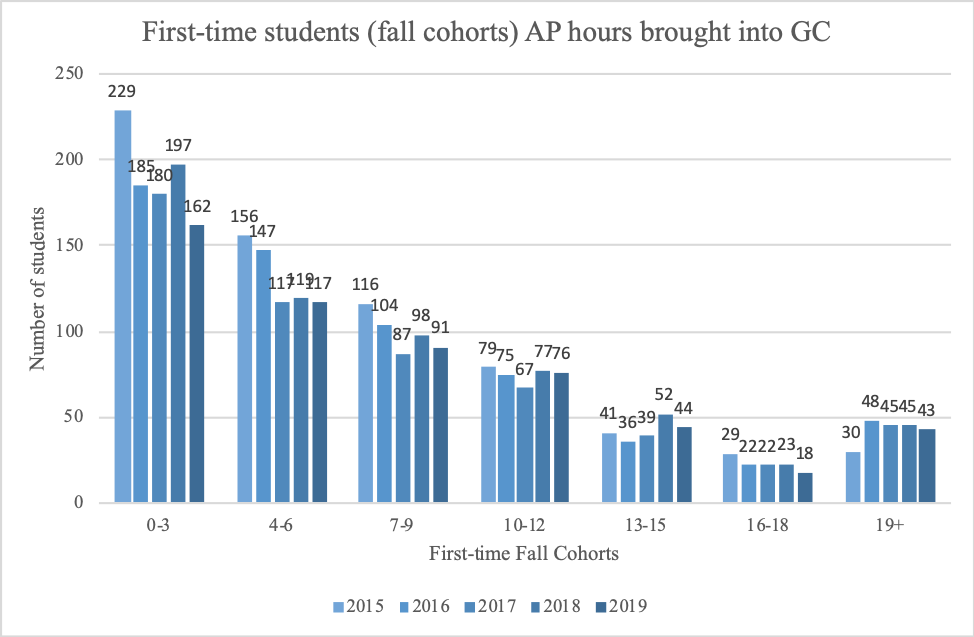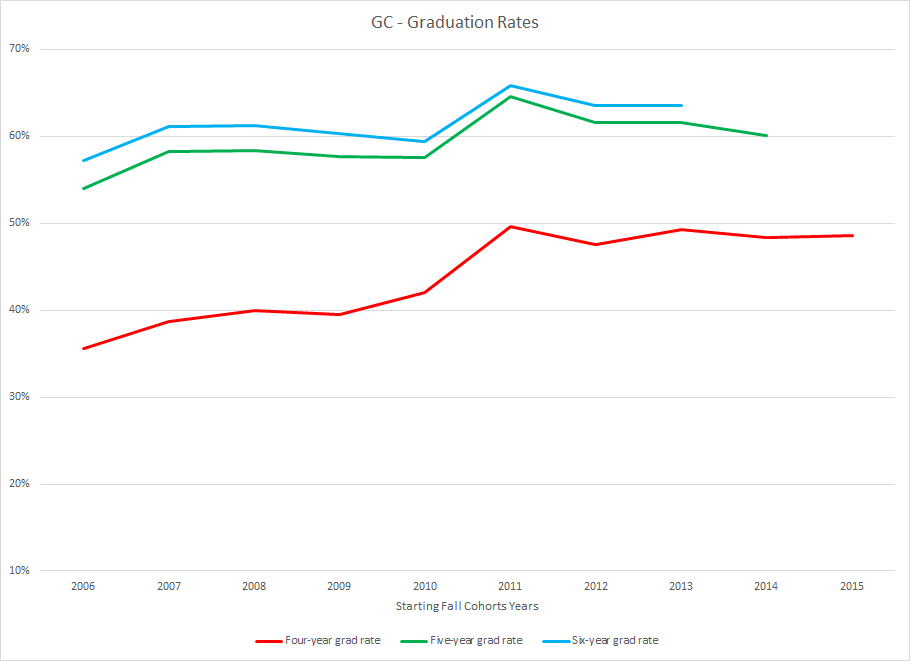Georgia College and State University Campus Plan Update 2019
INSTITUTIONAL MISSION
Georgia College & State University (Georgia College) remains committed to being an integral part of the University System of Georgia’s Complete College Georgia (CCG) initiative for creating a more educated state. The CCG Campus Completion Plan, initially developed by Georgia College in 2012, was built around its mission as Georgia’s designated public liberal arts university where excellence, engagement, and innovation are essential components of an educational experience that, according to its mission, “supports the needs of the region and creates pathways to individual success and personal fulfillment.” This sentiment remains today as Georgia College continues to refine and improve upon the CCG goals, strategies, and objectives previously developed.
STUDENT BODY PROFILE
Georgia College’s enrollment has been stable over the past ten years. First-time freshman enrollment (see Graph 1: First-time Full-time Students) was initially capped between 2007 and 2010 to support our mission but has experienced steady increases since 2011, growing from 1200 students to approximately 1480 students for the last three years. (See Graph 2: Fall Undergraduate Enrollment). Further enrollment growth at Georgia College is planned for graduate programs while maintaining undergraduate enrollment at its current levels.
The academic profile of the incoming classes improved in quality as evidenced in average SAT with an increase from the low 1100s in fall 2007 to high 1200s in fall 2019 (see Graph 3: First-time Average SAT). The average high school GPA has also steadily increased from fall 2007 to fall 2019 (see Graph 4: First-time Students Average HS GPA).
The diversity among our student body is illustrated in Graph 5: First-time Students by Race and Ethnicity. Reviewers will note the trend line for minority students, particularly African-American and Hispanic. The percentage of African-American students increased modestly from 2013 to 2014 while percentage of Hispanic students remained steady. While Georgia College continues to struggle with attracting first-year students from diverse populations, we are proud of the graduation rate of the students from minority ethnic groups who do attend. Georgia College has the second highest four-year graduation rate for African American students in the system and the third highest for Hispanic students. In coming years, Georgia College hopes to increase its minority student enrollment through the implementation of the initiatives outlined in its 2014 Diversity Action Plan and through the potential the College has to admit greater numbers of students from the Georgia College Early College Program.
Georgia College’s four-year graduation rate (see Graph 6: GC - Graduation Rates) rose by 10 percentage points between 2012 and 2015 from 39.93% to 49.55% (a 24% increase) and has remained steady at roughly 49% since 2011. We are hopeful that our strategies to increase the four-year graduation rate at Georgia College will help us achieve a 50% or greater four-year graduation rate in the next two years. Georgia College continues to be committed to its designated public liberal arts mission and the purposeful execution of activities designed to improve retention and graduation rates of its students.
2019 MOMENTUM YEAR UPDATE
Over the past year, Georgia College has worked steadily to implement all aspects of the Momentum Year Initiative. Students are being advised by advisors in their program focus areas and taught in focus-area first-year seminars by those advisors. Nearly all academic programs have program maps for planning their four-year curriculum. In the area of engagement, our GC Journeys program has been highlighted this year by a new administrator to help introduce the program to the faculty and the larger college community. Our focus this year has been on helping students make a “purposeful choice” in their major area during their first year.
In the Fall 2018, in order to assist students in choosing a degree program as part of our Momentum Year Plan, we added an option in our registration system (POUNCE) that steers undeclared students toward focus areas/meta majors. In order to further increase the number of students who at least chose a focus area, we introduced the concept of “focus areas” at orientations and created a video that can be shared as part of POUNCE. Previously undeclared students now choose a focus area as part of their POUNCE registration, and their first-year seminar will be in that focus area. The First-Year Seminar for undeclared students is by far the most helpful thing we do to provide guidance about academic and career choices.
Because of this new approach, we have seen a drastic increase in students choosing a focus area versus being undeclared. We are still not at 100%, and some students remain undeclared with no focus area. However, the numbers have greatly improved. In 2017, before focus areas were instituted, we had 221 undeclared majors or 15.3% of the first-year class of 1441. In 2018, we had 122 undeclared or 8.2% of the entering class of 1481. In Fall 2019, the number of undeclared majors continued to decline to 93 students or 6.72% of the first-year class of 1489 students.
Since advisors register students for the first term and help students create academic plans in First-Year Seminar, we are able to ensure key academic milestones in the fall term: Students complete core English and Math courses within the first 30 hours, complete the correct Area A Math course, take courses in their selected major, and complete 30 credit hours overall.
Our emphasis on “purposeful choice” extends beyond students’ initial first-year choice of degree program. Starting this Fall (2019), as part of GC Journeys (which houses our Momentum Year Plan), we have scaled the idea of “purposeful choice” within each academic degree program. We are asking students to learn about “high-impact practices” (we call them “transformative experiences”) and ask students to choose these experiences purposefully during their four years at GC. Throughout their time in the GC Journeys program, each student will participate in five transformative experiences. Upon graduation, students will be fully prepared to enter graduate school or the workforce and take on the challenges and realities of today’s information-intensive and vastly diverse global society. As part of this purposeful choice, we are in the process updating all of our advising program maps to reflect these transformative experiences within the four-year plan for the major.
OTHER INSTITUTIONAL HIGH-IMPACT STRATEGIES, ACTIVITIES, AND OUTCOMES
This narrative report describes the strategies that Georgia College implemented this year to address three of the Complete College Georgia goals designated by the University System of Georgia: (1) to increase access for underserved and/or priority communities, (2) to shorten time to degree completion through programs that allow students to earn college credit while still in high school, and (3) to provide intrusive advising to keep students on track to graduate.
Our work focusing on increasing the number Early College students who graduate from high school and attend college addressed the first goal. Our work focusing on providing high school students opportunities to increase the number of AP credits that they can use to facilitate their completion of core credits addressed the second goal, and our work focusing on increasing the graduation rate of regularly enrolled students who enter the fall semester of their senior year with 90+ hours addressed the third goal. While we continue to have advising and engagement strategies in place to increase first-year and second-year student retention, we believe that the greatest immediate impact on graduation rates at Georgia College will come from focusing on the students who are closest to completing their degree.
HIGH-IMPACT STRATEGY #1: Increase the number of undergraduate degrees awarded by USG institutions by increasing high school completion from Georgia College Early College.
Completion Goal: This high-impact strategy aims to increase high school completion from the GC Early College (EC) program by 5% annually and increase earning of college credits by the time of high school graduation by 5% over the next three years.
Demonstration of Priority:
This strategy is a priority because of its potential to have a direct, positive impact on over 250 high school students in Middle Georgia through increased high school graduation rates, college admission and completion and to increase diversity at Georgia College.
Summary of Activities:
We attribute the continued rise in the number of students graduating from the Early College program at Georgia College over the past two years to the initiatives implemented by the EC and GC administration, faculty mentors, student groups, academic advisors, and the clear goals set by the director of the EC program.
Collaboration and goal setting with GC administration
Efforts by the GC administration during the 2018-2019 academic year to maintain communication with GC EC - to provide support, initiate programming, and set goals - have helped to increase graduation from EC over the last two years. These conversations greatly improved communication. The goal of the EC is for all seniors to graduate and be admitted to institutions of higher education (i.e. colleges and universities).
Collaborations between EC and GC faculty
EC and GC faculty members are working together to create small group tutoring sessions to address the basic skills needed for students to succeed in college core courses. GC EC teachers have engaged in collaborative planning and team teaching with college professors to address those areas where students need to be successful. These intentional efforts are paying off for EC and GC faculty and the students, as evidenced by all but one of the seniors in the EC program being accepted into college.
Mentoring EC students
GC work-study students from the GC College of Education have spent much of their time working with EC students as peer mentors. Mentors and EC students met once a week to discuss the challenges of applying to college, what to expect in college, and how to survive and thrive once they enroll.
Outreach from the GC Male Connection
The MALE Connection is GC’s African-American Male Initiative, supported by the USG’s African-American Male Initiative (AAMI), which started in 2002. The MALE Connection, an acronym for Mentoring African-Americans for Leadership, Education and Connection, includes over 50 participants, over half of whom are EC and high-achieving male students who are mentored by our undergraduate students. Of the 35 seniors graduating from GC EC, 10 of those students are male, which we attribute in large measure to the success of the mentoring and outreach of the MALE Connection with EC male students. Chiefly, this outreach involved biweekly sessions with EC students, usually led by our undergraduate members of AAMI.
Highlighting the Success of Students Admitted to College
This spring, EC again hosted spring Signing Day, where each student admitted to a college was announced, applauded, and accompanied on stage by alumni from the college to “sign” their commitment to attend the college where they had received admission. The public acknowledgement in front of parents and other GC students, the presence of alumni from the respective colleges, and the general excitement that included balloons and cheerleaders that is often part of athletic signing day were excellent ways to make acceptance to college a fun and inspiring experience for the students, the alumni, and their parents.
Baseline Measure of Success:
In 2011, EC enrolled 168 students. Since that time, except for a small dip in numbers in the 2014-2015 year, the enrollment has steadily increased from 168 to 286 students in the 2018-2019 academic year (70% increase). Each year, nearly all of the students graduating from Early College have enrolled in college after graduation. The number of students who have attended college after Early College has increased from 10 to 37 over the past ten years. This year, the number graduating from Early College dipped slightly by 2 students; but the trajectory for increased enrollment continues to be upward. Since 2011, the number of Early College students attending Georgia College has fluctuated between 0 students to a high of 9 students in the 2015-2016 academic year. This year, two Early College students are attending Georgia College. While Early College students do not always attend Georgia College, the support of Georgia College faculty, staff, and students who support the Early College Students has helped to contribute to their success in completing high school and attending other colleges in Georgia. This year, 34 of the 35 students who graduated from Early College enrolled in colleges in Georgia (23 USG, 4 GMC, 1 Spelman College, 1 Brenau University, 1 Shorter University) and other select colleges in the southeast: 3 are enrolled at Tuskegee University, and 1 is enrolled at the University of North Texas. One student will join the military (U.S. Airforce) and continue post-secondary education.
Georgia College Early College Completion Data
| Academic Year | Total GCEC Enrollment | Graduating High School (Attended GC) | % of Original Class of 55* | Continuing @ IHE | **Dual Enrollment Range of College Credits Earned by GCEC graduates |
| 2011-12 | 168 | 10 (1) | 18.2% | 10 | 15-29 |
| 2012-13 | 194 | 11 (0) | 20% | 11 | 13-26 |
| 2013-14 | 229 | 19 (5) | 34.5% | 19 | 15-37 |
| 2014-15 | 216 | 12 (2) | 22% | 12 | 9-32 |
| 2015-16 | 234 | 26 (9) | 47.27% | 26 | 9-42 |
| 2016-17 | 255 | 25 (1) | 45.45% | 25 | 9-62 |
| 2017-18 | 280 | 37 (0) | 67.27% | 37 | 9-98 |
| 2018-19 | 286 | 35 (2) | 63.63% | 34 (1) | 20-102 |
*Students graduating from GC EC compared to original class enrollment **Number of college credits awarded to GC EC graduates in each of the past six years
Lessons Learned:
Given the varied backgrounds of EC students, often without a tradition of family members who have attended college, comprehensive mentoring, engagement, and celebration of their achievements are important factors that contribute to their readiness, their acceptance, and their retention in college.
HIGH-IMPACT STRATEGY #2 Shorten the time to degree through programs that allow students to earn college credit while still in high school and by awarding credit for prior learning that is verified by appropriate assessment.
Completion Goal: Since the requirements to enroll in Dual Enrollment changed this year, GC set no specific target for completion this year. Generally, we would like to increase the number of students enrolled in the Dual Enrollment (DE) program, as well as enroll more first-year students who possess acceptable AP and DE credits. Given the recent changes in DE criteria, goals will be determined annually by the Registrar and the Provost.
Demonstration of Impact:
Increasing the number of dual enrolled students taking GC classes and the number of students earning college credit prior to high school graduation is a high-impact strategy that can have a positive impact on graduation rates at Georgia College and in the state as a whole. For the past several years, GC Dual Enrollment numbers typically hovered between 70 and 80 students. Beginning Fall 2019, however, a new admission criterion was introduced, requiring Dual Enrollment applicants to have attained HS junior status prior to enrolling in GC Dual Enrollment classes. This change, combined with other factors regarding access and long-term planning, led to a precipitous drop in our Dual Enrollment of approximately 50 percent to 39 students. The next several years will, therefore, be devoted to accessing goals and capacity to help us continue to deliver a Dual Enrollment program that ensures even greater success for our students.
In addition to offering Dual Enrollment on our campus to our local area high school students, Georgia College also encourages entering students to enroll in advanced credit opportunities prior to arriving at GC, such as AP courses in high school and dual enrollment classes at their local-area colleges.
AP score reports received during AY18 indicate that 611 entering first-year students (38.65% of the entering class) received AP credit from AP and IB exams that equates to an average of 8.18 credit hours per student. AP score reports for AY 19 indicate that 551 first year students (37.4 % of the entering class) received AP credit from AP and IB exams that equates to an average of 8.36 credit hours per student. This is a 2.2% credit hour increase over last year’s average, even with fewer total students bringing in AP credit. Additionally, 540 first-year students in the AY 19 first-year class (36.6% of the entering class) brought in Dual Enrollment credit averaging 17.24 credit hours per student. This is a 1.51 average credit hour increase over the previous year of 15.73 average credit hours. Combined, our entire entering first-year class in fall 2019 brought in 13,915 credit hours via both programs. This represents a 27.4% increase over the previous year’s total of 10,920 hours.
With over 1000 students impacted by both of these programs that shorten the time to degree, Georgia College has the potential to increase significantly its four-year graduation rate.
Summary of Activities:
Outreach to Local Schools
Georgia College Office of Admissions has reached out to local schools to offer assistance for students enrolling dually in high school and college. Admission counselors also work with high school counselors to encourage students all over Georgia to take advantage of dual enrollment opportunities in their local communities to gain advance credit and also improve their admission portfolio when considering application to Georgia College. Georgia College has an advisor specifically designated to work with Dual Enrollment students.
Offer Dual Enrollment and AP Course Credit
In addition to offering Dual Enrollment, Georgia College offers entering students Advance Placement (AP) courses in high school with the intent to exempt college courses by AP exam score. Students are advised of the potential for AP credit through direct mailings, the admissions website, and at recruitment and orientation events.
Baseline Measure of Success:
This fall, Georgia College has 551 fall 2019 first-year students who arrived with AP credit, compared to last fall’s 611. This fall, Georgia College has 540 first-year students who brought in dual enrollment credit, compared to 420 in fall 2018. Of that total, 56 students brought in Dual Enrollment credit of 19 hours or above, 50% more than those who brought in 19 hours of Dual Enrollment the following year. While AP credits have fluctuated each year, Dual Enrollment credit has risen. This may be indicative of student choice since there is more certainty with dual enrollment credit, and there is no cost for the student. We are working to increase these numbers, as guided by the USG, in the coming years.
Lessons Learned:
We have learned that Dual Enrollment can positively impact the matriculation and subsequent graduation of students from college by providing free tuition for dually enrolled students and that encouraging students to take AP credits pays off in the number of students who enter the university with college credit. Both of these measures—increased numbers and increased credits—are positive indicators for greater numbers of Georgia students completing college.
HIGH-PRIORITY STRATEGY #3: Provide Intrusive Advising to keep students on track to graduate.
Completion Goal: Increase four-year graduation rate at Georgia College to 50% or above by 2020.
Demonstration of Priority:
For over ten years, Georgia College’s graduation rate remained steady in the 30% range. In the spring of 2015, however, the graduation rate increased by 10 percentage points—from approximately 39% to 49%. Our assessment of the reasons for this increase were intentional changes in advising and course delivery (summer online courses and the benefits of centralized advising), closer monitoring of waitlists and DFW rates. In order to prevent the graduation rate from slipping again, academic advisors engaged this year in a more comprehensive intrusive advising effort to monitor the progression of those students closest to completing the hour requirements of the institution. Intrusive advising for these students included early transcript reviews before the semester began and one-on-one advising interventions at the beginning of the fall semester to ensure that the seniors were aware of and had plans to meet all graduation requirements. Other intrusive advising strategies during the semester included monitoring course availability in the major for the spring and summer semesters, discussing schedules with department chairs to ensure proper course sequencing, sending alerts and reminders of important dates and deadlines, and addressing other structural issues that could prevent timely graduation.
Summary of Activities:
This year, intrusive academic advising for seniors included three components.
Targeted Intrusive Advising for Seniors.
There were 1473 students who entered Georgia College as full-time freshmen in the fall of 2015. By fall 2018, 935 students in that class, or 63.47%, remained at Georgia College with 90 hours and the potential to graduate on time. These 935 students were the students targeted for intrusive senior advising. In July and August, advisors began transcript reviews, phone calls, emails, and in-person conferences with these students. In early October prior to spring registration, advisors completed a second review to determine what requirements these students still needed to meet and what obstacles would likely prevent timely graduation. These actions revealed students who had still not completed graduation applications, who needed to complete course petitions, who were having financial difficulties, who were struggling academically in their courses, and who needed to complete legislative exams. In most cases, early identification of these obstacles allowed advisors to intervene quickly and find solutions. Advisor conversations and transcript reviews with students also shed light on structural obstacles resulting from scheduling difficulties in majors that have course pre-requisites that were not being met due to scheduling conflicts and departmental regulations. These intrusive advising strategies, targeted specifically at those seniors who were eligible to graduate, not only kept seniors on track but also helped to initiative policy changes in some departments whose policies were inadvertently delaying student progression and graduation.
Advisor Follow Up and Analysis.
In early November, near the end of the fall semester, and again in March in the middle of spring semester, advisors were tasked with checking the progress and status of the students with 90+ hours completed. Using the data provided by the Office of the Registrar, each student was evaluated for completion of the graduation application, completion of testing requirements, satisfaction of institutional and major credit-hour requirements, academic performance in current classes, and completion of internships. Advisors intervened when necessary to help students complete these requirements so that they could satisfy requirements for graduation. Advisors were successful with several of the interventions, particularly with completing graduation applications and the state legislative test requirements and in some cases encouraging faculty to change summer scheduling to make sure that students had opportunities to finish all major requirements in time for summer graduation. In meeting with the Provost and the Director of Academic Advising, advisors discussed outcomes of the follow-ups, made a list of which students were expected to graduate in their majors and which were not expected and why. They also began a list of suggested recommendations to be presented in a full Senior Progression report that would be shared with the Provost and Deans. The advisors continued to monitor seniors’ progress to make sure that those who had met requirements continued to progress satisfactorily for spring graduations.
Senior Progression Report.
In April 2019, the Associate Provost for Student Success presented an eight-page document, the Senior Progression Report, to the Provost and Academic Deans. The Report outlined the retention numbers of the fall 2015 cohort by class, the number of students expected to graduate in each major by term, the number expected not to graduate, and the reasons why. The report also included a list of recommendations for both departmental and institutional changes that could positively impact student progression and timely graduation. Deans shared this report with faculty to review the numbers and discuss the recommendations.
Measures of Progress and Success:
The success of Intrusive Advising was measured in the following ways: (1) comparing the number of students who graduated in 2018 with the number who graduated in 2019, (2) identifying obstacles that prevented students from progressing, (3) developing strategies for addressing the obstacles to graduating in four years.
Outcomes.
Of the 935 students remaining in the fall 2015 cohort, 742 students, according the advisors’ projections in the Senior Progression Report, were expected to graduate by spring or summer of 2019 if they passed courses in which they were now enrolled and on track to finish. Actual graduation numbers for the fall 2015 cohort, after spring and summer graduations, showed that 716 students in the fall 2015 cohort graduated, resulting in a four-year graduation rate of 48.60% rather than the 50.34% which advisors had projected in the Progression Report. While the expected number of four-year graduates for 2019 fell short of the expected number, the four-year graduation rate did increase, if only slightly, over the graduation rate for 2018 (from 48.39% in 2018 to 48.60% in 2019). The overall number of graduates, representing cohorts from as far back as 2012, also increased slightly from 1242 to 1263 (or a 1.69% increase). While the 716 seniors who graduated in four years represented only 48.60% of the entire cohort who entered in fall 2015 (1473), those 716 seniors represented 76.5% of the number of seniors from the 2015 entering class who remained at the university at the beginning of their senior year (935). By these measures, our graduation numbers both for four years and overall increased (if only slightly). Moreover, these numbers demonstrate that, while we do not do as well with the entire entering cohort (approximately 35% leave by the beginning of their junior year), Georgia College does graduate nearly 80% of students who remain at the college through their senior year. We believe that the intrusive advising measures helped these numbers, even with increased enrollments, remain steady. But more importantly, the intrusive advising measures employed to complete the Senior Progression Report identified more clearly what the obstacles to graduation were and where advisors could intervene to improve the graduation numbers. In future years, we hope to increase both our retention rate and the four-year graduation rates of those students who remain through their senior year. Increasing the graduation rate of those who remain to 85% or 90 % would boost our overall four-year graduation rate between 6 to 8 percentage points, well within the range of a 53% to 55% targeted four-year graduation goal.
Obstacles:
Each advisor prepared a written report on the progression of the seniors that he or she advised. These reports were compiled by Lead Advisors in each Cluster with an analysis that included the number of students expected to graduate, those who were not expected, and the reasons why. Of the 935 seniors with 90 hours or more, 193 (20.6%) were not expected to graduate for the following reasons—academic performance (75), course scheduling and sequencings (16), desire to stay longer to complete a minor or prepare for graduate school (30), change of major (22), delayed cohort entry (22), health reasons (15), five-year program (8), and withdrawals (5). Surprisingly, for many of us, given the academic profile of our students, the analysis indicated that the highest number (75 students / 38.8% of this group) would not be graduating because of academic performance. Because academic performance was the greatest obstacle to graduation for these students, advisors then conducted a detailed analysis of the academic reasons students are not graduating. The major reason is performance in a major course, but seniors not completing perquisites in the required sequence, withdrawing, and incompletes were also academic issues that caused delays in timely progression.
Recommendations:
The Senior Progression Report, resulting from the intrusive advising of seniors, included a list of twelve recommendations to improve timely progression of seniors. These included greater use of academic maps by faculty and by advisors in advising students for better course selection and understanding of sequencing requirements, restricting registrations to make sure that sequencing policies are followed, offering required courses more frequently, reviewing departmental policies to allow students to take pre-requisites earlier if students are ready, making sure that perennially difficult courses are assigned a supplemental instruction leader, and having earlier deadlines for grade reporting for internships. These recommendations were passed on to the Provost and deans for subsequent discussions with department chairs.
Lessons Learned:
The Intrusive Advising activities, especially the Senior Progression Report, provided much actionable information about why the students in the 2015 cohort did not graduate in four years. While most Georgia College students who stay all four years perform well academically and progress satisfactorily, the report indicated that there were a significant number of students (75+12 we did not predict or 5.9% of the fall 2015 cohort) that did not graduate in four years due to poor academic performance. Given our faculty, our academic support programs, and a major-focused professional academic advising team, we believe that we can intervene and help these students graduate on time.
We learned that there are structural issues in course sequencing and course availability that impact the ability of students to take the courses that they need in a timely manner. In the course of this reporting, advisors were able to reach out to faculty in impacted departments and were successful in some cases in departments increasing course availability and in rethinking course sequencing for better student access. Advisors noted that, in addition to poor academic performance by a small but significant number of students, there is also a growing number of students who are having both mental and financial difficulty that keep them from remaining at Georgia College and graduating in four years. Overall, intrusive advising helped us understand more clearly the areas where we need to intervene early with students in order to avoid delays later in the years. That will be our major focus in advising seniors going forward.
OBSERVATIONS AND NEXT STEPS
Compared to all other institutions in the USG, Georgia College is performing well in the area of four-year graduation. At 48.60% this year, we are second overall in four-year graduation rates; and compared to other institutions in our sector, we consistently out-pace our peers by as much as 10 percentage points. We understand that higher retention rates of first-year and second-year students could positively impact our graduation rates, and we are working proactively with both classes to increase these retention numbers. This year, however, in our work conducting the research and compiling the data included in our Senior Progression Report, we focused mainly on why the seniors who remain at Georgia College through their junior year are not graduating in four years.
We are not content to accept our current graduation rate. We are working diligently to identify the obstacles that prevent timely graduation and will marshal all of our resources - faculty, academic advising, financial aid, counseling services, and other USG initiatives - to increase our graduation rate to our targeted goal. Next year, we will continue the intrusive advising that will result in a Senior Progression Report submitted to the Provost in early April. Given our specific focus now on improving the academic performance of enrolled students, we will be meeting with department chairs to discuss and assess course scheduling, course sequencings, and advising that facilitate timely progression. We will hold a focused meeting with the Learning Center Director to ensure supplemental instruction in courses that perennially delay progression, and we will be reviewing data and outcomes from the G2C initiative and assessing the impact that restructuring instructional delivery in early core courses on student progression and graduation.
STUDENT SUCCESS COMPLETION TEAM
Carolyn Denard, Associate Provost for Student Success
Michelle Johnson, Director of Academic Advising
Nikki Simpson, Assistant Director of Academic Advising
Chris Ferland, Associate Vice President for Institutional Research and Effectiveness
Runee Sallad, Director of the Early College Program
Suzanne Pittman, Associate Vice President for Enrollment Management
Kay Anderson, Registrar
Mike Augustine, Advisor of Dual Enrollment Students

